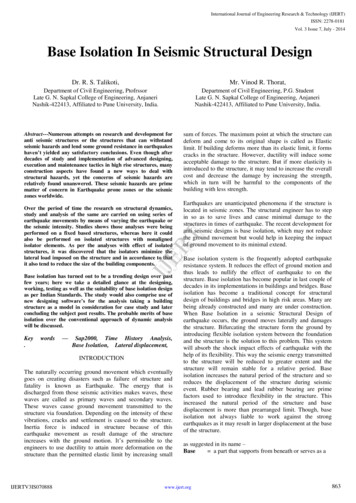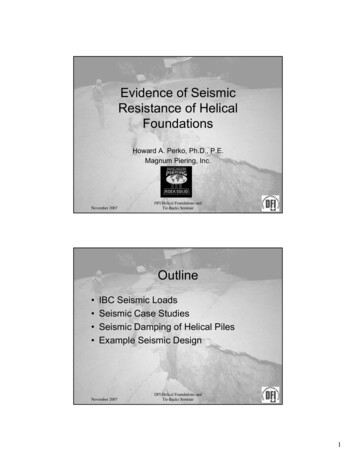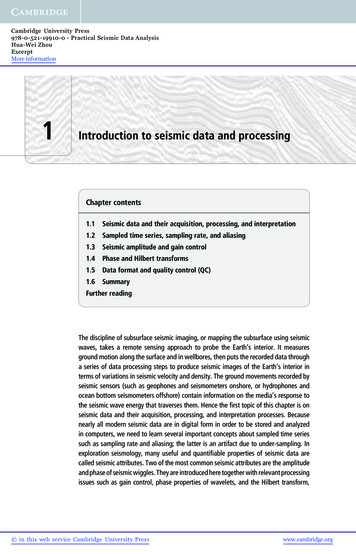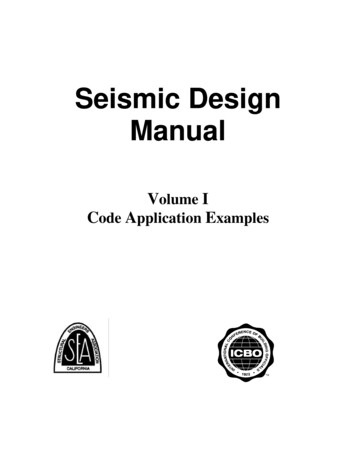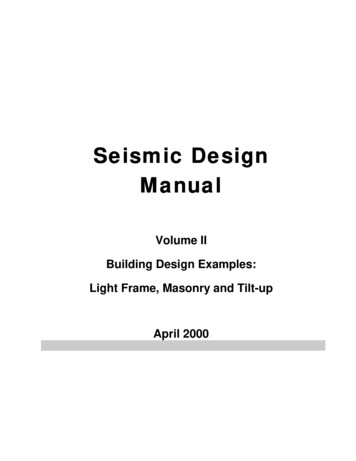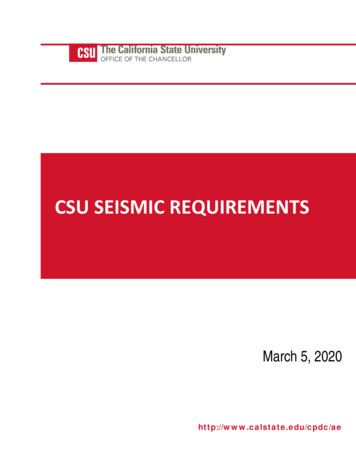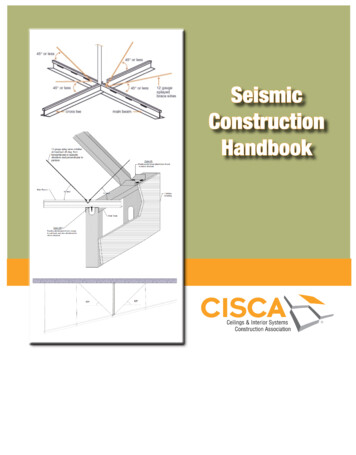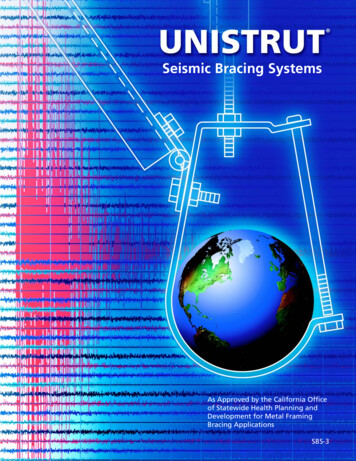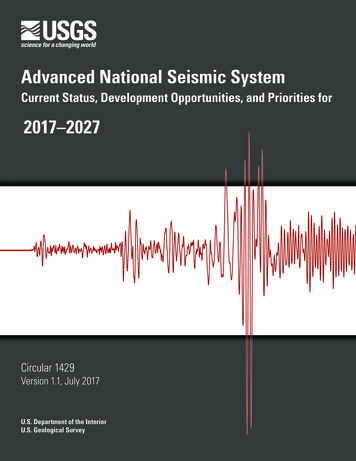
Transcription
Advanced National Seismic SystemCurrent Status, Development Opportunities, and Priorities for2017–2027Circular 1429Version 1.1, July 2017U.S. Department of the InteriorU.S. Geological Survey
Advanced National Seismic SystemCurrent Status, Development Opportunities, and Priorities for2017–2027By U.S. Geological SurveyCircular 1429Version 1.1, July 2017U.S. Department of the InteriorU.S. Geological Survey
U.S. Department of the InteriorRYAN K. ZINKE, SecretaryU.S. Geological SurveyWilliam H. Werkheiser, Acting DirectorU.S. Geological Survey, Reston, VirginiaFirst release: 2017Revised: July 2017 (ver. 1.1), online and in printFor more information on the USGS—the Federal source for science about the Earth,its natural and living resources, natural hazards, and the environment—visit https://www.usgs.gov/ or call 1–888–ASK–USGS (1–888–275–8747).For an overview of USGS information products, including maps, imagery, and publications,visit https://store.usgs.gov.Any use of trade, firm, or product names is for descriptive purposes only and does not implyendorsement by the U.S. Government.Although this information product, for the most part, is in the public domain, it also maycontain copyrighted materials as noted in the text. Permission to reproduce copyrighted itemsmust be secured from the copyright owner.Suggested citation:U.S. Geological Survey, 2017, Advanced National Seismic System—Current status, development opportunities,and priorities for 2017–2027 (ver.1.1, July 2017): U.S. Geological Survey Circular 1429, 32 p.,https://doi.org/10.3133/cir1429.Library of Congress Cataloging-in-Publication Data:Names: Geological Survey (U.S.), author.Title: Advanced National Seismic System--current status, developmentopportunities, and priorities for 2017-2027 / by U.S. Geological Survey.Other titles: U.S. Geological Survey circular ; 1429. 1067-084XDescription: Reston, Virginia : U.S. Geological Survey, 2017. Series:Circular, ISSN 1067-084X ; 1429 Includes bibliographical references.Identifiers: LCCN 2017021417 ISBN 9781411341364 ISBN 1411341368Subjects: LCSH: Advanced National Seismic System (U.S.) Seismicnetworks--United States.Classification: LCC QE540.U6 G46 2017 DDC 551.2028/7--dc23 SUDOC I19.4/2:1429LC record available at https://lccn.loc.gov/2017021417ISSN 1067-084X (print)ISSN 2330-5703 (online)ISBN 978-1-4113-4136-4
PrefaceThis Circular presents an updated strategic plan for the U.S. Geological Survey-ledAdvanced National Seismic System (ANSS). It was produced at the request of theANSS National Steering Committee with input from all of those who cooperate in theANSS. The ANSS is a cooperative effort that emphasizes regional implementation andnational integration. Progress has been made possible by dedicated community,including the ANSS regions, organizations represented in the ANSS Steering Committee,and organizations participating in the ANSS, as highlighted below.ANSS RegionsAlaskaCaliforniaHawaiiIntermountain WestCentral and eastern United StatesPacific NorthwestPuerto Rico and U.S. TerritoriesOrganizations Represented inANSS National Steering CommitteeAssociation of American State GeologistsConsortium of Organizations for Strong Motion Observation SystemsEarthquake Engineering Research InstituteIncorporated Research Institutions for SeismologyNational Emergency Management AssociationSeismological Society of AmericaU.S. Geological SurveyOrganizations Participating in ANSS in 2016Alaska Earthquake Center, University of Alaska, FairbanksCenter for Earthquake Research and Information, University of MemphisEarthquake Center, Saint Louis UniversityLamont-Doherty Cooperative Seismographic Network, Columbia UniversityNevada Seismological Laboratory, University of Nevada, RenoPacific Northwest Seismic Network, University of Washington and University of OregonPuerto Rico Seismic Network, University of Puerto Rico, MayagüezSeismograph Stations, University of UtahSeismological Laboratory, California Institute of TechnologySeismological Laboratory, University of California, BerkeleySouth Carolina Seismic Network, University of South CarolinaU.S. Geological Survey (USGS) Earthquake Science Center, Menlo Park, Calif.USGS Geologic Hazards Science Center, Golden, Colo.USGS Hawaiian Volcano Observatory, Hawaii National Park, Hawaii
AcknowledgmentsThis report was written by Cecily Wolfe and John Filson ofthe U.S. Geological Survey (USGS). This document benefittedfrom input from all of the Advanced National Seismic System(ANSS) community. Especially recognized for their contributionsare the members of the ANSS National Steering Committee,the ANSS National Implementation Committee, and theScientific Earthquake Studies Advisory Committee to theUSGS Earthquake Hazards Program; and Greg Beroza ofStanford University; Bill Leith, David Applegate, Paul Earle,and Lind Gee of the USGS; and Walter Arabasz and Kris Pankowof the University of Utah.
ive Summary.viiiIntroduction.2Background.4History of the Advanced National Seismic System.4Basic Concepts of Seismic and Real-Time Geodetic Networks.4Overview of the Current Advanced National Seismic System.6Elements of the Advanced National Seismic System.6Organization and Coordination.9Advanced National Seismic System Progress to Date (2000–2016).9Network Infrastructure.9Standardization and Coordination.10Partnerships in Growth.10Products and Services.12Advanced National Seismic System Development Opportunities (2017–2027).18Ensuring Readiness in an Earthquake Crisis.18Advancing Earthquake Safety in Urban Areas.22Developing Earthquake Early Warning Systems.22Developing High-Resolution Damage and Impact Assessments for Urban Areas.22Developing High-Resolution Damage and Impact Assessments forCritical Facilities and Lifelines.22Implementing Aftershock Forecasting as a National Capability.24Expanding the Observational Database for Earthquake Risk Reduction.24Monitoring Data for Determining the Seismic Response of Structuresand Lifelines.24Developing Comprehensive Assessments of Human-InducedEarthquake Hazard and Risk.24Incorporating Geodetic Data into Rapid, ComprehensiveEarthquake Impact Assessments.26Improving Coverage in the Central and Eastern United States.26Expanding Coverage in Areas of High Seismic Hazard.26Conclusions.27References Cited.28
viAppendix: Planning Considerations for 2017–2027.29Current Resources and Responsibilities.29Development Needs and Outcomes for 2017–2027.29Opportunity A. Ensuring Readiness in an Earthquake Crisis.29Opportunity B. Advancing Earthquake Safety in Urban Areas.30Priority B.1. Developing Earthquake Early Warning Systems.30Priority B.2. Developing High-Resolution Damage andImpacts Assessment for Urban Areas.30Priority B.3. Developing High-Resolution Damage andImpact Assessments for Critical Facilities and Lifelines.30Priority B.4. Implementing Aftershock Forecasting as a National Capability.31Opportunity C. Expanding the Observational Database forEarthquake Risk Reduction.31Priority C.1. Monitoring Data for Determining theSeismic Response of Structures and Lifelines.31Priority C.2. Developing Comprehensive Assessments ofHuman-Induced Earthquake Hazard and Risk.31Priority C.3. Incorporating Geodetic Data into Rapid,Comprehensive Earthquake Impact Assessments.31Priority C.4. Improving Coverage in the Central and Eastern United States.32Priority C.5. Expanding Coverage in Areas of High Seismic Hazard.32Resources—Existing and Needed.32Sidebars1.2.3.4.5.6.7.8.9.10.United States National Seismic Hazard Model.3Contribution of Geodetic Data in the Advanced National Seismic System.5Distribution of Advanced National Seismic System Seismic Stations.7Instrumented Structures in the Advanced National Seismic System.8Growth in the Number of Advanced National Seismic System Stations.11ShakeMap.13Prompt Assessment of Global Earthquakes for Response (PAGER).19Did-You-Feel-It?.20Earthquake Early Warning.23Induced Seismicity.25TableA1. Advanced National Seismic System current annual resources and augmentationto resource allocation needed to fully implement each development opportunityfrom 2017 to 2027.32
viiAbbreviationsANSSAdvanced National Seismic SystemASLAlbuquerque Seismological LaboratoryCaltechCalifornia Institute of TechnologyCESMDCenter for Engineering Strong Motion DataCEUSNCentral and Eastern United States NetworkCGSCalifornia Geological SurveyCISNCalifornia Integrated Seismic NetworkComCatANSS Comprehensive CatalogDOTDepartment of TransportationDYFIDid-You-Feel-It?EEWearthquake early warningENSEarthquake Notification ServiceFEMAFederal Emergency Management AgencyFYfiscal yearGNSSGlobal Navigation Satellite SystemGPSGlobal Positioning SystemIRISIncorporated Research Institutions for SeismologyMmagnitudeMEMSmicro-electro-mechanical systemNEHRPNational Earthquake Hazards Reduction ProgramNEICNational Earthquake Information CenterNOAANational Oceanographic and Atmospheric AdministrationNRCU.S. Nuclear Regulatory CommissionNSFNational Science FoundationNSHMNational Seismic Hazard ModelPAGERPrompt Assessment of Global Earthquakes for ResponsePBOPlate Boundary ObservatorySESACScientific Earthquake Studies Advisory CommitteeUSAID/OFDAU.S. Agency for International Development, Office of Foreign Disaster AssistanceUSGSU.S. Geological SurveyVAU.S. Department of Veterans Affairs
Advanced National Seismic SystemCurrent Status, Development Opportunities, and Priorities for2017–2027By U.S. Geological SurveyExecutive SummaryEarthquakes pose a threat to the safety of over 143 millionpeople living in the United States. Earthquake impacts can besignificantly reduced if communities understand their risk andtake proactive steps to mitigate that risk. The Advanced NationalSeismic System (ANSS) is a cooperative effort to collect andanalyze seismic and geodetic data on earthquakes, issue timelyand reliable notifications of their occurrence and impacts, andprovide data for earthquake research and the hazard and riskassessments that are the foundation for creating an earthquakeresilient nation.As a result of investments made in the ANSS, any earthquakeof significance in the United States or anywhere in the worldcan now be rapidly characterized by a suite of products, providingsituational awareness during times of crisis. ANSS monitoringserves scientific research and earthquake engineering needs,including advancing the understanding of how buildings andother structures perform in an earthquake.As one of four Federal agencies participating in theNational Earthquake Hazards Reduction Program (NEHRP),the U.S. Geological Survey provides management and financialsupport for the ANSS. Congress established the ANSS as aNEHRP facility in the 2000 reauthorization of the NEHRP(Public Law 106–503).The ANSS is a collaboration of Federal, State, and academicpartners. Recognizing that earthquake hazard and risk variesfrom region to region, the ANSS management structureemphasizes regional implementation and national integration.Its organization allows collaboration with other Federal andState agencies and with the earth science and engineeringcommunities with interests in seismic monitoring.The ANSS promotes partnerships among those workingat local, regional, and national levels committed to reducingearthquake losses. These partnerships are necessary in orderfor the ANSS to be coordinated nationally, designed andimplemented regionally, and supported locally. Moreover,host academic institutions, some State agencies, other Federalagencies, private foundations, and scientific organizationshave contributed support to ANSS growth and (or) operations.The ANSS requirements were originally described ina U.S. Geological Survey (1999) publication entitled“An Assessment of Seismic Monitoring in the United States—Requirement for an Advanced National Seismic System”;these needs included strengthening coordination among thenation’s monitoring networks, developing new earthquakeinformation products, and expanding monitoring infrastructurenationwide. Since 2000, the ANSS has strengthened infrastructureand partnerships, and developed new earthquake informationproducts and services. Although the funding to fully implementthe ANSS vision has not been realized, at the end of fiscal year2016 the ANSS achieved 42 percent of the goal set in 1999for the installation of 7,100 modern seismic stations in thefree field and in buildings, bridges, and other structures. Thetimeliness and usefulness of ANSS products have increasedthe expectations of its capabilities within government agencies,emergency responders, the public, and the engineering andscientific communities.
Executive Summary 1The reporting of earthquakes has been revolutionized asa result of ANSS investments. Notable ANSS products andservices include immediate earthquake notifications togovernments and emergency managers, rapid notification by emailor text via the Earthquake Notification Service, earthquakesource characteristics, ANSS websites with real-time earthquakeinformation, a suite of real-time situational awareness products(ShakeMap, ShakeCast, Prompt Assessment of GlobalEarthquakes for Response [PAGER], Did-You-Feel-It?), acatalog of information (the ANSS Comprehensive Catalog),and products for engineers served by the Center for EngineeringStrong Motion Data.To meet the expectations of the next decade, the ANSS mustfocus on improving the robustness of essential services andretaining capacity for future innovation. The ANSS has thecapacity to further improve earthquake safety and supportresponse and recovery nationwide. This document describes a setof specific development opportunities that form ANSS prioritiesfor the next decade to ensure ANSS readiness in an earthquakecrisis, advance earthquake safety in urban areas, and expand theobservational database for earthquake risk reduction. Additionalfunding would be necessary to realize these opportunities.When the ANSS was formed, it was viewed as an innovativebut risky endeavor, yet now it has proved successful despitebeing only partially funded. Resting on past accomplishmentsand accepting the status quo will increase exposure to earthquakerisks as our nation grows and its structural systems expandand become more complex. To fully realize its loss reductionpotential, the ANSS must move forward—the tectonic forcesthat cause earthquakes are relentless, they will not stop andneither can efforts to reduce their impacts throughout the Nation.
2 Advanced National Seismic System —Current Status, Development Opportunities, and Priorities for 2017–2027IntroductionEarthquakes are a national hazard (sidebar 1, p. 3), withmore than 143 million people exposed to potentially damagingshaking in the United States (Jaiswal, Petersen, and others,2015). There are tens of thousands of earthquakes abovemagnitude (M) 2.5 strong enough to be felt in the UnitedStates each year. Large earthquakes ( M5) pose threats to thesafety of individuals and to the national economy, infrastructure,and security.Estimated long-term “annualized earthquake losses” fromearthquakes in the United States are over 4.5 billion per year(Jaiswal, Bausch, and others, 2015). This estimate is only forbuilding-related losses, and does not include components suchas utility and transportation losses, business interruption, andthe losses associated with deaths and injuries. The M7.8 1906San Francisco earthquake is known as the most devastatingU.S. earthquake on record, but the Nation’s history containsmany earthquakes whose repeat occurrence today would becatastrophic, including those in southeastern Missouri in 1811and 1812 (three events greater than M7); southern Californiain 1857 (M7.9); Hawaii Island in 1868 (M7.9); Charleston, S.C.,in 1886 (M7.3); the Pacific Northwest in 1700 (M9); and Alaskain 1964 (M9.2). Recent damaging earthquakes in the United Statesillustrate potential economic losses: 6 to 10 billion inLoma Prieta (M6.9, San Francisco, Calif., 1989), 20 billionin Northridge (M6.7, Los Angeles, Calif., 1994), and 2 billionin Nisqually (M6.8, Seattle, Wash., 2001). International examplesinclude 100 billion in losses in Kobe, Japan (M6.9, 1995), 30 billion in Maule, Chile (M8.8, 2010), 30 billion inChristchurch, New Zealand (M6.1, 2011), and 300 billion inTohoku, Japan (M9.0, 2011).The Advanced National Seismic System (ANSS) is acooperative effort to collect and analyze seismic and geodeticdata on earthquakes, issue timely and reliable notifications oftheir occurrence and impacts, and provide data for earthquakeresearch and the hazard and risk assessments that are thefoundation for creating an earthquake-resilient nation. Life-savingand loss-reduction measures require accurate, timely earthquakeinformation, and the benefits of fully deploying the ANSS farexceed the costs of building and operating it (National ResearchCouncil, 2006). Members of professions working to mitigateearthquake risks depend on monitoring: for example, earthscientists focused on the cause and nature of strong shaking andthe quantification of the hazard, and earthquake engineersworking to design safe structures. Other users include emergencymanagers, insurance professionals, economists, and policyanalysts. Earthquake monitoring information is critical foreffective building codes that support nearly 1 trillion in newconstruction each year in the United States.The vision of the ANSS is to provide the earthquake dataand information needed to save lives and reduce earthquakeeconomic losses, as a foundation for creating a more earthquakeresilient nation.The mission of the ANSS is to provide accurate and timelydata and information on seismic events and their effects onbuildings and infrastructure, to cooperatively develop andmaintain the system with consistent analytical procedures, andto develop information products and services necessary forearthquake warnings, notifications, impact estimates, hazardand risk assessments, and scientific and engineering research.There are four areas in which ANSS earthquake monitoringhas practical application to public safety through earthquakeloss reduction:Public awareness.—The ANSS rapidly provides informationon earthquake occurrence, characterizing any seismic eventcausing public concern for situational awareness. There is greatdemand for such information in times of crisis: following alarge earthquake, ANSS websites can receive millions of visits.Through the earthquake early warning (EEW) initiative, theANSS is developing the capability to issue alerts of imminentstrong ground shaking.Emergency response.—ANSS information on the severityand spatial distribution of earthquake shaking and the likelysocietal impacts is essential to give rapid estimation of the scopeof damages and losses for emergency response. The ANSSalso enables earthquake scenarios that are used in emergencymanagement exercises.Earthquake hazard assessment and risk mitigation.—ANSS information and complementary geologic data form thebasis of hazard assessments used in building codes and otherrisk-reduction measures (such as the National Seismic HazardModel, which is a suite of products aimed at improvingearthquake-resilient construction in the United States).Earthquake and engineering research.—The ANSS providesdata and derived products needed to develop our understandingof the causes of earthquakes, their likelihood, and their impacts,including impacts on the built environment. ANSS recordingsof strong ground shaking and associated building responseare used in the development of seismic-resistant engineeringdesign and construction practices.
Introduction 31. United States National Seismic Hazard ModelE arthquake hazards nationwide are quantified in the National Seismic Hazard Model (NSHM) (such asmap below), which is a suite of products aimed at improving earthquake-resilient construction in theUnited States. Engineers who construct buildings need to know how strongly a particular site might beshaken by earthquakes. The NSHM addresses this question by compiling all known earthquake sources(and proxies for unknown sources), their distance from the site in question, and other seismological andgeological information to project potential maximum expected ground motions at a site over a particularperiod of time (for example, 50 years) (see Petersen and others, 2014). The NSHM is revised periodicallyto include new research results on earthquake faults, ground deformation, and earthquake ground shaking.The NSHM relies on Advanced National Seismic System information.EXPLANATIONALASKAPeak acceleration,expressed as a percentageof standard gravity (g)Highest hazard 6448–6432–4816–328–164–8 4Lowest hazardHAWAIIMap of seismic hazard across the United States derived from the National Seismic Hazard Model. Colors on this particular map showthe levels of horizontal shaking that have a 2% chance of being exceeded in a 50-year period. Shaking is expressed as a percentage of g,which is the acceleration of a falling object due to gravity, with red colors indicating highest shaking and thus highest hazard.
4 Advanced National Seismic System —Current Status, Development Opportunities, and Priorities for 2017–2027BackgroundHistory of the Advanced National Seismic SystemThe ANSS is an essential component of the U.S. GeologicalSurvey (USGS) contributions to the four-agency NationalEarthquake Hazards Reduction Program (NEHRP), consistingof the National Institute of Standards and Technology, NationalScience Foundation (NSF), Federal Emergency ManagementAgency (FEMA), and USGS. Congress established the ANSSthrough the Earthquake Hazards Reduction Act of 2000(Public Law 106–503), directing the USGS “.to establishand operate an Advanced National Seismic Research andMonitoring System to modernize, standardize, and stabilizethe national, regional, and urban seismic monitoring systemsin the United States into a coordinated system.” The originalANSS design was set down in USGS Circular 1188 entitled“An Assessment of Seismic Monitoring in the United States—Requirement for an Advanced National Seismic System”(U.S. Geological Survey, 1999). Technical guidelines for ANSSimplementation were detailed in a subsequent document, USGSOpen-File Report 2002–92 (ANSS Technical ImplementationCommittee, 2002).This current document describing ANSS developmentalopportunities and priorities for the next decade (2017–2027) hasbeen written at the recommendation of the ANSS SteeringCommittee and its parent body, the Scientific EarthquakeStudies Advisory Committee (SESAC), which was establishedby Congress to advise the Director of the USGS on mattersrelated to the USGS participation in the NEHRP.Basic Concepts of Seismic and Real-TimeGeodetic NetworksA seismic station consists of a sensor to measure groundmotion—a seismometer—and an instrument to convert theanalog electrical signal to digital format. Because of the broadrange of motions generated by earthquakes, two types ofsensors are typically employed. Broadband seismometers canrecord ground motions (velocity or acceleration) that vary overmany orders of magnitude (1 to 1,000,000) and over a widerange of frequencies, whereas strong-motion seismometers areneeded to record the shaking near large earthquakes, both onthe ground and in buildings and lifelines. Many ANSS stationsconsist of both broadband and strong-motion sensors to ensurethat the full range motions are recorded with fidelity.A seismic network consists of a group of stations feedingdata to a data analysis center. They are typically described interms of their scale of coverage. National and global networksprovide wide areal coverage, and regional networks consist ofmore densely spaced seismometers in areas of higher seismichazard to detect lower magnitude earthquakes and increase theaccuracy of earthquake characterization. Data analysis centersaggregate data from many seismic stations to produce accurateearthquake products.A seismic station with broadband and strong-motion sensorsrecorded at 100 samples per second would produce approximately14 kilobits per second of data. These data are transmittedcontinuously, using various types of communication pathways,to a data center for analysis. A data center using a network of100 stations would acquire and process over 400 gigabytes ofdata per month. These data must also be archived and freelyand openly distributed for long-term research.Seismic network operations require an expert staff ofscientists, engineers, and technicians who analyze earthquakes;manage software, computers, data flow, and communications;and conduct fieldwork to maintain seismic stations.The opportunities described herein include a new rolefor geodetic networks, identifying a pathway to eventuallybecome participating networks in the ANSS. A real-timegeodetic network uses high-precision Global PositioningSystem (GPS) stations (more generally called GlobalNavigation Satellite System [GNSS] stations) to rapidlymeasure ground displacement. Geodetic and seismic data arecomplementary, and joint analysis can better characterize anearthquake. Real-time GNSS data are particularly importantfor rapidly characterizing large earthquakes for earthquakeearly warning and in resolving detailed characteristics of faultslip (sidebar 2, p. 5).
Background 5of Geodetic Data in the Advanced2. ContributionNational Seismic SystemThe potential contribution of real-time geodetic data from Global Navigation Satellite System (GNSS)networks to rapid earthquake characterization was demonstrated retrospectively for the Tohoku-Okiearthquake (left plot). For the largest earthquakes, GNSS data can provide a
from input from all of the Advanced National Seismic System (ANSS) community. Especially recognized for their contributions are the members of the ANSS National Steering Committee, the ANSS National Implementation Committee, and the Scientific Earthquake Studies Advisory Committee to the USGS Earthquake Hazards Program; and Greg Beroza of


